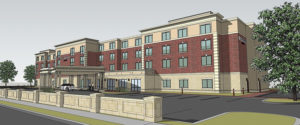NATIONAL REPORT—Hotel projects under contract and in construction in the U.S. are on the rise. Compared with January 2016, the number of rooms under contract increased 16.1% and the number of rooms under construction jumped 27.3%, according to STR’s Pipeline Report. Construction companies are expecting to win new projects in the new year by leveraging existing relationships and specializing in particular project types. Despite a positive forecast for 2017, builders are being cautiously optimistic about the market’s status in the long term—looking past the influx of projects throughout this year.
There are currently 1,449 projects with 190,301 rooms in the pipeline under construction in the U.S., according to the same report. The data revealed 4,763 projects with 575,907 rooms under contract (which includes projects currently in construction, final planning and planning stages).
“We expect supply to increase over the next 24 months and the under-contract numbers to increase, as well,” said Jan D. Freitag, SVP of lodging insights at STR. “The industry is doing well, RevPAR growth is positive and money is cheap. This is fertile ground for further construction.”
According to STR’s report, more than 31% of total U.S. hotel construction is presently occurring in 10 major markets: New York; Dallas; L.A./Long Beach, CA; Seattle; Houston; Denver; Las Vegas; the Washington metropolitan area; Nashville; and Chicago.
“Those gateway markets have seen strong demand growth in the past and have been perennial favorites with developers,” Freitag explained. “All major brands want to be first and foremost in the coastal markets. Yes, we expect construction to be strong in those markets going forward. That said, as land and construction prices in the top 25 markets increase, other, secondary markets become much more attractive.”
Not surprisingly, New York City reported having the most rooms under contract (29,132 rooms) and most rooms in construction (15,607 rooms), according to STR’s data. Three markets reported having more than 15,000 rooms under contract for January: Dallas (18,463 rooms); Houston (17,693 rooms); and L.A./Long Beach, CA (16,338 rooms). Only two markets in addition to New York reported having 5,000-plus rooms in construction: Dallas (7,228 rooms) and L.A./Long Beach (6,070 rooms).
As these markets become flooded, construction companies begin looking elsewhere for opportunities. Some are targeting potential real estate properties in the mid-Atlantic region, while others are staying West. “Currently, the greatest opportunity for our firm is in the L.A. market, which has picked up a lot of traction with the renovation/adaptive reuse model,” said Bill Wilhelm, president of R.D. Olson Construction, a general contractor and construction management firm situated in Irvine, CA. “We are also focused on projects in Orange County, as well as the Southern California desert area, where we have had project teams consistently active for more than five years.” In addition to California, his firm is also assessing projects in both Arizona and Texas.
More often than not, construction companies are finding themselves specializing in regions where their offices are located, but that doesn’t mean they’re not branching out to other markets. “We have offices in Texas and California, so these areas are always a focus,” said Noah Alpern, founder and CEO of Triple Mint, a hotel renovation company. “We are one of the few hotel renovation companies that do work all over the country. This past year we have done work in California, Oklahoma, Wisconsin and Ohio.”
Many builders are relying on relationships and strategic partnerships to acquire new projects—focusing on their respective niches and clientele. “We’ve found that by building strong partnerships with clients, the referral program is our best marketing tool,” Wilhelm said. “We’re always looking for new opportunities and will continue to expand into new markets based on where our partnerships are taking us.” For Triple Mint, partnering with large hotel management companies and private equity firms assists with its search of finding new projects to add to its portfolio. “There is a mutual trust, which provides us with multiple projects from our same clients,” Alpern said.
Project selection varies between companies—some focus on brands, others on service. “We are continuing to serve our niche hotel segment, which is select-service and full-service hotels, ranging anywhere from 100-500 room properties,” said Chris Rapp, president at Triple Crown Construction LLC. “We will do public space projects with or without guestroom projects. Our target focus for growth is full-scale properties in the 300-500 room size, boutique properties and resorts. We entertain any project with scopes ranging from simple refreshes to full-blown renovations with shower conversions.”
Conversion and renovation projects seem to be a major initiative this year for many builders who are dedicating entire teams and employees to those specializing in these projects. Some construction companies are also finding renovation projects to be the most profitable. “Throughout the next 18 months we will continue to see a shift toward hotel repositioning and renovation,” Wilhelm said. “Renovation projects typically have the ability to be more profitable because they present greater risks.” Similarly, Triple Crown Construction finds projects involving soft-goods renovations to be the most profitable. “We are also focusing on other types of projects mainly to diversify, but we definitely see a greater demand for full-service property renovations,” Rapp pointed out.
Construction companies are in agreement on how the market’s current landscape will affect projects in the foreseeable future. The outlook—being mostly positive—remains to be a driver for many builders. “I believe the market will once again have a very healthy year,” Wilhelm said. “The hospitality industry has always been responsive to the economics of geographies and regions. These factors will continue to drive the success of various hospitality property types this year.” Michel Gibeault, VP of business development at High Construction Company, said his company, based in Lancaster, PA, is “feeling very good about 2017.” He acknowledged the continuation of low interest rates but also recognized a small potential uptick in the Federal Reserve rate.
While builders are in agreement on the market’s optimism in the short term, they’re being a bit more cautious about how it will all unfold in the long term. “It’s important to seek out work that is the right fit for long-term success,” Wilhelm said. “As firms enter the market, it’s imperative to focus on timing and ask what financing will bear today.”
Speaking on the market’s future, Rapp—who also raised some concern over the country’s political environment—noted: “I believe the market will plateau in 2018 based on my discussions with ownership groups regarding their pipelines and plans.” HB


